Whip Finishing: “Whip Me!”
HOW TO MAKE a whip-finish was one of the first things I learned as a fledgling fly tier. Howard LeMasurier, my first and blessedly patient instructor, taught me the two-handed method without resorting to using a whip-finishing tool. It served me well for years, but I was always a gadgeteer and eventually bought a Thompson whip-finishing tool. I never became comfortable using it.
In the summer of 1985, I was tying flies at the Federation of Fly Fishers annual conclave in West Yellowstone, Montana. As I concentrated on making a perfect whip-finish, a spectator asked in a determined voice, “Why are you still doing that knot by hand?” It was Frank Matarelli.
He handed me one of his patented whip-finishing tools and showed me how it worked. He made a believer out of me.
Matarelli’s new whip-finishing tool was easy to use and produced a perfectly tied knot. I’ve been using it ever since. Later, Frank came out with a second version called the long-reach whip-finishing tool. It works the same but is more versatile because it can place a whip-finish knot at the rear or center of a large fly.
The major difference between the Matarelli and the D. H. Thompson whip-finishing tools is that the shaft of the Matarelli revolves within a brass tube, and the unique design of the forward parts makes it a joy to use.
After I retired from my real job and started attending various fly-tying shows, I learned that people like to see a little showmanship. To wow the crowds, I learned the one-handed whip-finish method. It’s the same knot and can be tied very quickly, especially by those who use it exclusively. I once managed a commercial fly-tying factory in Thailand. The female tiers were paid on a production basis—the more flies they tied, the more money they earned. All the women used the single-handed whip-finish to boost their output. They were so fast, you couldn’t follow their hands.
Tie One On
Okay, so what is a whip-finish? To describe it simply, a whip-finish is a slip knot or “noose” that is formed around the head of a fly or anywhere else on the hook you wish to place the knot. You then tighten the slip knot to bind the loose end of the thread to the hook shank. Let’s call this loose thread, which goes to the bobbin, the standing thread. I typically make five wraps of thread around the hook and standing thread before cinching the knot. You may make a whip-finish with more or fewer wraps of thread, but I suggest using no less than four.
The photo sequences demonstrate all three methods (see the third, fancier technique here) of making the whip-finish. The resulting knots are all the same. Ideally, the wraps should progress in a forward direction (toward the hook eye) so the standing thread is completely buried under the knot when you tighten the thread. This reduces the chance of the knot coming apart when you fish the fly.
Without a Tool |
|
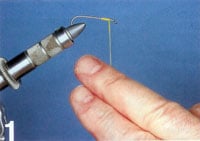 |
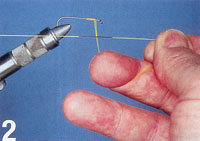 |
| 1. Pull enough thread out of the bobbin so that the tool will not interfere with the whip-finish. (The bobbin is hanging below, out of the photograph.) Press the side of the right middle finger against the thread. (All the instructions are for a right-handed tier. Just reverse hands and directions if you’re a southpaw.) | 2. Pull on the bobbin to maintain tension, and grasp the thread with the right thumb and index finger. Loop the thread around the middle finger. Note that the thread now crosses above the index finder and forms a triangle below the hook. (The author applied a dash of black marker to the thread to aid readers in the following steps.) |
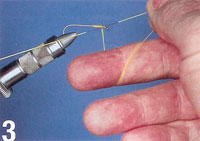 |
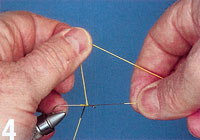 |
| 3. Slide the horizontal piece of thread (we’ll call this the standing thread) up to the hook. Continue to maintain tension on the thread. This is where we will tie the whip-finish. | 4. The left hand now releases the bobbin and grasps the triangle of thread. use the left hand to wrap the thread around the hook; pass the thread to the right hand and then back to the left hand with each wrap. The thread coming off the fly must remain in position at the front of the hook as it is covered with the wraps. Make four or five wraps of thread. |
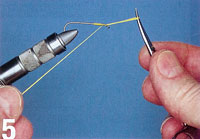 |
|
| 5. Continue to maintain tension on the loop of thread. Slip a bodkin needle or closed scissors into the loop. Use the scissors to maintain tension on the loop. Grasp the bobbin, and begin pulling the thread and tightening the whip-finish knot. The tool is drawn to the hook as you close the noose. When the tool reaches the hook, give the bobbin a light tug while simultaneously slipping the scissors our of the noose. This completes the whip-finish; you may now clip the thread. | |
With a Tool |
|
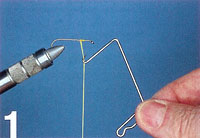 |
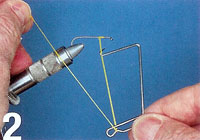 |
| 1. A whip-finishing tool looks like something from a medieval torture chamber, but it really is a handy little device. It will help you make neater, more durable flies. In the following instructions the author demonstrates how to use the Matarelli whip-finisher. Every fly shop carries this common fly-tying tool.
Maintain tension on the thread. Hook the whip-finishing tool on the thread. Notice that the hook is in front of the thread. |
2. Wrap the thread behind and under the whip-finisher, passing the thread over the indented portion in the tool. Important: The right thumb and forefinger grasp the head of the tool so that it is immobilized for the moment. |
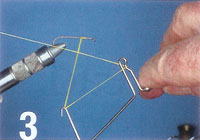 |
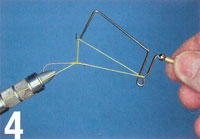 |
| 3. Release the head of the tool so that it flops 180 degrees; the tool will actually rotate in the handle. This forms the same triangle shape loop that we created when we tied the whip-finish without a tool. Be sure to maintain tension throughout the procedure. | 4. Turn the handle around the fly to wrap the thread on the hook. The head of the tool will rotate inside the handle. Make four to six wraps of thread. |
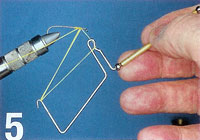 |
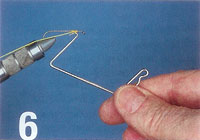 |
| 5. Tilt the tool counterclockwise (raising the handle and lowering the hook). Slip the thread off the base of the tool. | 6. Pull the bobbin to tighten the knot; continue maintaining tension on the loop of thread with the hook. Slip the hook from the thread and tighten the whip-finish. Clip the thread. |











